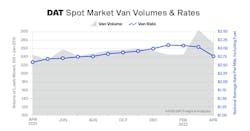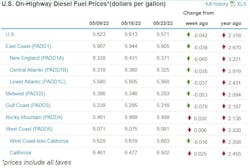More data sees TL volumes in retreat, spot market in freefall
Truckload freight volumes retreated and spot-market rates dropped sharply in April, adding pressure on small and independent freight haulers already strained by record diesel prices, according to DAT Freight & Analytics.
The Truck Volume Index (TVI) for April by DAT, operators of the truckload freight marketplace and the DAT iQ data analytics service, for dry van freight was 273, 10% lower compared to March. The refrigerated TVI was 190, down 10%, and the flatbed TVI was 229, a 6% decrease.
See also: Survey points to exodus of small operators—and fuel costs as the culprit
Truckload volumes typically decline from March to April, with freight movement in a seasonal lull, according to DAT. Year-over-year, the April TVI was 12% higher for van freight, 10.5% higher for reefers, and 15.1% higher for flatbed loads, indicating strong overall demand for truckload services.
The national average price to move van freight under contract remained at $3.26 per mile in April, extending the previous monthly high. The average contract reefer rate was $3.43 a mile, unchanged from March, while the flatbed rate rose 9 cents to $3.79 a mile.
Spot-market outlook trends sharply down
Spot-load posting activity fell on the freight marketplace by 27% in April, according to a DAT release. On the spot market—where load terms are negotiated as one-time transactions between freight brokers and carriers—the supply of trucks outpaced demand and drove rates substantially lower, the release said.
The national average van rate fell 28 cents to $2.77 per mile, the lowest monthly average since August 2021. The spot reefer rate was $3.13 per mile, down 32 cents, and the flatbed rate was unchanged at $3.40 per mile, a record high.
See also: Diesel levels off as key index sees deteriorating shipping conditions
Spot rates incorporate a fuel surcharge. Removing fuel, the van rate averaged $2.13 a mile; the reefer rate was $2.43 a mile; and the flatbed rate was $2.63 a mile. The national average price of diesel fuel was $5.12 per gallon, up 2 cents compared to March and $1.99 higher year-over-year.
“Our April TVI data supports what we’ve been communicating for months: Shippers are seeing increased routing guide compliance at the same time truckers on the spot market are contending with extreme volatility in lower rates and higher fuel costs,” said Ken Adamo, DAT’s chief of analytics. “We expect these conditions to continue. However, we have yet to see the glut of capacity and overall lack of freight that produced a prolonged down-cycle in late 2018 and 2019.”
A Truckstop.com survey, results from which were released May 17, showed that half of all small operators are contemplating job changes as high diesel costs have buffeted their businesses. Another indicator, FTR’s Shippers Conditions Index, fell to a record low in March following the surge in diesel prices of the past few months. The index had set a record low in February as well. The index is a measure of the trucking industry’s health at a glance—and the outlook doesn’t appear in some quarters to be good.
About the Author
Scott Achelpohl
Managing Editor
Scott Achelpohl is a former FleetOwner managing editor who wrote for the publication from 2021 to 2023. Since 2023, he has served as managing editor of Endeavor Business Media's Smart Industry, a FleetOwner affiliate.



